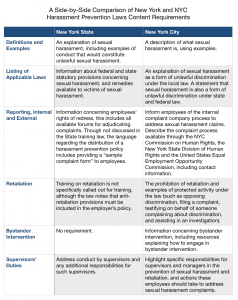The preamble to the NY State legislation aimed at preventing workplace sexual harassment indicates that the bill is comprehensive and multi-faceted. It enacts an approach “to help prevent sexual harassment in the workplace, ensure accountability, and combat the culture of silence that victims face.” It goes on to say, “this bill will help ensure that all employees are provided with a safer work environment.” This language drives home a point that we see surfacing not only in New York, but throughout the country: State legislatures are taking a comprehensive and serious approach to tackle this complex issue.
Our prediction? This is the beginning of a trend that will include enactment of mandatory harassment prevention training requirements in other parts of the country. But for now, the question is, how do New York employers comply?
New York’s sweeping harassment-prevention legislative scheme includes new mandates related to policies, arbitration agreements, and confidentiality (non-disclosure) agreements, among other topics. Central to the state’s goal of taking affirmative steps to protect New Yorkers from exposure to sexual harassment is a new mandatory training requirement.
Parallel to the state’s new laws, New York City (NYC) has also enacted its own mandates, including sexual harassment prevention training requirements.
With some mandates going into effect in a matter of weeks, employers with operations in New York state and/or New York City have questions about how to comply. We’ve compiled the most frequently asked questions about the new laws—and their answers:
When do the harassment prevention training laws go into effect?
- The New York state law becomes effective on October 9, 2018.
- The NYC law becomes effective on April 1, 2019.
Who must receive harassment prevention training?
- In New York State, all employers (no matter what size) will be required to provide sexual harassment prevention training to all employees.
- The NYC law applies to employers with 15 or more employees and covers all workers who work in the City of New York. Under the City mandate, all employees (including interns) must receive the training.
How often must you train?
- Both the state and city laws require annual training.
- In NYC, new hires must receive training within 90 days of hire, unless they received training at a previous employer.
What type of training is required?
- Both laws require interactive training.
- Although the state law does not provide a definition of “interactive,” employers can look to the definition in the city law which defines interactive training as “participatory teaching whereby the trainee is engaged in a trainer-trainee interaction, use of audio-visuals, computer or online training program or other participatory forms of training as determined by the commission. However, such ‘interactive training’ is not required to be live or facilitated by an in-person instructor in order to satisfy the provisions of this subdivision.”
- For online training, until New York drafts its own implementing regulations, the best practice is to follow the detailed guidance outlined in California’s AB1825 regulations. In short, interaction for online training means 1) the course cannot be “plug-and-play” (it must require learners to advance through sections, answer questions, watch scenarios, etc.) and 2) the learner must be able to ask the training developers (who must be subject matter experts) questions and have those questions answered within a few days.
What training content is required?
- For the most part, both laws coincide in terms of content. Although worded in slightly different ways, both laws require that the training address:
- The definition of unlawful sexual harassment
- Examples of unlawful harassment (the City law says the training should discuss what harassment is and isn’t through the use of practical examples)
- Information on how to report harassment, both internally and externally
- An explanation of retaliation and a statement regarding the prohibition of retaliatory conduct
- An explanation for supervisors to help them understand their responsibilities – to refrain from engaging in harassing conduct, and to report misconduct they observe or know about
- See the below table that further outlines the specific content requirements.
What are the unique aspects of the NYC law regarding content and record-keeping?
- The NYC law specifically requires that the training cover bystander intervention. Although the State law does not have a similar requirement, all state employers should strongly consider including bystander training in their harassment prevention programs.
- The City law also requires employers to generate and maintain records of all training sessions, including signed acknowledgments. These records must be kept for three years. Again, although the State did not address this specific requirement, it’s always a best practice to keep these types of training records.
Will further guidance and model programs be available?
- The State law directs the New York Department of Labor to consult with the state’s Division of Human Rights to ”produce a model sexual harassment prevention training program to prevent sexual harassment in the workplace.” Employers can use this model training program, or can another training provider, as long as the training they select meets or exceed the legal requirements. The Department is scheduled to release this model program prior to the enactment date (October 9, 2018).
- Similarly, the NYC law instructs NYC Commission on Human Rights to “develop an online interactive training module that may be used by an employer as an option to satisfy” the training requirements, provided that “an employer shall inform all employees of any internal complaint process available to employees through their employer to address sexual harassment claims.” Like the State law, the NYC law makes it clear that the model policy establishes a minimum threshold and does not prohibit an employer from providing more frequent or additional training.
- We should also expect the corresponding State and City agencies to draft clarifying regulations, although there is no timeline on completing that work.
Takeaways and Action Items
TRAINING. Since the State and City requirements overlap in some instances but differ in others, the best practice will be to meet the more rigorous standards to ensure compliance. We recommend:
- Design and immediately begin to schedule annual training sessions for ALL employees and develop a training calendar to ensure all employees are trained every year. Make sure your training methodology incorporates a mechanism through which employees can acknowledge they have completed the training.
- Make sure new hires are either trained upon hire, or obtain proof that they received adequate training at a previous employer.
- For content, make sure to provide definitions and examples – not only of unlawful harassment, but less severe but prohibited behavior that, if left unaddressed, could escalate. See the below for additional content detail.
- Content should also address complaint mechanisms, issues related to retaliation, and bystander intervention.
- Make sure the training is interactive, including giving employees the ability to ask questions and have them answered by the subject matter experts who develop the training.
- Make sure you maintain records and that you have a mechanism through which you can easily produce a report to show compliance

